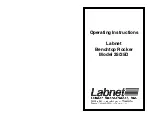
4
5
from other devices, the user is encouraged to try to correct the
interference by one or more of the following measures:
•
Reorient or relocate the receiving device.
•
Increase the separation between the equipment.
•
Connect the equipment into an outlet on a circuit different
from that to which the other device(s) are connected.
•
Consult the manufacturer.
8
.
The HTSS’s maintenance port is to be used by Hemostatix
personnel only. The port is not to be accessed, for any purpose, by
the customer. Any attempt to connect via the maintenance port
will result in a termination of any warranties that may exist and
may damage the unit.
9
.
The HTSS’s auxiliary port is not to be utilized for any other
purpose other than to power equipment specifically designed
by Hemostatix. Any attempt to plug, non Hemostatix
equipment
into the output connector may result in damage to
the
Hemostatix unit thereby terminating any warranties and
may
result in an unsafe electrical condition, increased electrical
emissions, or decreased immunity of the Hemostatix system.
Anyone who connects additional equipment via the auxiliary
output terminal is therefore responsible for configuring a medical
system and is responsible that the newly configured system
complies with the requirements of the system standards IEC
60601-1 and IEC 60601-1-
2
. If the user has questions regarding
any connections to the AUX output port, they should contact
Hemostatix Medical Technologies.
SYSTEM PRECAUTIONS
1. It is important that the Hemostatix Thermal Scalpel System
(HTSS) operator be familiar with the System’s Operator’s
Manual, its precautions, procedures, and safety issues. Read the
complete operators manual before using this equipment.
2. Do not position the HTSS unit to make it difficult to remove and
insert the unit’s separable power cord plug.
3. Hazardous electrical and thermal outputs. This equipment to be
used only by qualified medical personnel.
4. Disconnect power to the HTSS before cleaning the unit to avoid
electrical shock.
5. To avoid the risk of electrical shock, achieve electrical grounding
reliability with proper connections. Connect the HTSS unit to
hospital grade receptacles only.
6.
The HTSS should not be used adjacent to or stacked with
other equipment. If adjacent or stacked use is necessary, the
HTSS should be observed to verify normal operation in the
configuration in which it will be used.
7
.
8
Do not operate the HTSS in the presence of Magnetic Resonance
Imaging Equipment.
The recommended temperature setting for skin incisions is 70°
C.
For minimal scarring, make the initial skin incision with
the scalpel handle in the OFF position. Cutting with the blade
unheated will eliminate the possibility of superficial skin scars due
to contact with a heated blade.
9
.
User should select the lowest set point temperature that will
afford
adequate hemostasis for the maximum anticipated rate of
tissue
cutting, thereby minimizing unnecessary (thermal) necrosis
of
tissue.
10
.
Care should be taken when using the HTSS to dissect around
nerves and other delicate structures to avoid thermal injury to
these structures.
11
.
The Model P8400 Hemostatix Thermal Scalpel System needs
special precautions regarding EMC and needs to be installed and
operated according to the information in the tables presented at
the back of this manual and portable and RF communications
equipment can affect the operation of the product.
12
.
All service must be performed by Hemostatix Medical
Technology
personnel only.
13
.
Repair and/or modification the HTSS by anyone other than
qualified service personnel may significantly compromise the
unit’s
ability to perform effectively and/or void the equipment
warranty.
14
.
Opening the HTSS unit and/or breaking the tamper-proof seal
will void the equipment warranty.
15
.
Hemostatix Thermal Scalpel handles are
single-use devices
.
If required by local code, connect the HTSS unit to the hospital
equalization connector with an equipotential cable.
Lists of all compatible components of the Model P8400
Hemostatix Thermal Scalpel System are provided on pages
14-15 of this manual.
16
.
17
.




































